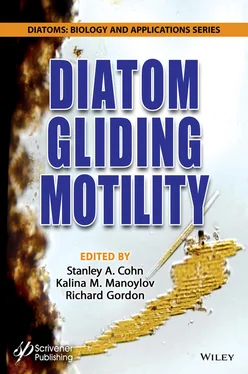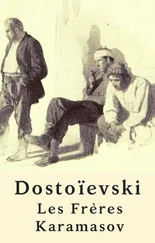1 Cover
2 Title Page
3 Copyright
4 Dedication to Jeremy D. Pickett-Heaps In Memoriam 1940–2021
5 Preface
6 1 Some Observations of Movements of Pennate Diatoms in Cultures and Their Possible Interpretation 1.1 Introduction 1.2 Kinematics and Analysis of Trajectories in Pennate Diatoms with Almost Straight Raphe along the Apical Axis 1.3 Curvature of the Trajectory at the Reversal Points 1.4 Movement of Diatoms in and on Biofilms 1.5 Movement on the Water Surface 1.6 Formation of Flat Colonies in C ymbella lanceolata 1.7 Conclusion References
7 2 The Kinematics of Explosively Jerky Diatom Motility: A Natural Example of Active Nanofluidics 2.1 Introduction 2.2 Material and Methods 2.3 Results and Discussion 2.4 Conclusions Appendix References
8 3 Cellular Mechanisms of Raphid Diatom Gliding 3.1 Introduction 3.2 Gliding and Secretion of Mucilage 3.3 Cell Mechanisms of Mucilage Secretion 3.4 Mechanisms of Gliding Regulation 3.5 Conclusions Acknowledgments References
9 4 Motility of Biofilm-Forming Benthic Diatoms 4.1 Introduction 4.2 General Motility Models and Concepts 4.3 Light-Directed Vertical Migration 4.4 Stimuli-Directed Movement 4.5 Conclusion References
10 5 Photophobic Responses of Diatoms – Motility and Inter-Species Modulation 5.1 Introduction 5.2 Types of Observed Photoresponses 5.3 Inter-Species Effects of Light Responses 5.4 Summary References
11 6 Diatom Biofilms: Ecosystem Engineering and Niche Construction 6.1 Introduction 6.2 The Microphytobenthos and Epipelic Diatoms 6.3 The Ecological Importance of Locomotion 6.4 Ecosystem Engineering and Functions 6.5 Microphytobenthos as Ecosystem Engineers 6.6 Niche Construction and Epipelic Diatoms 6.7 Conclusion Acknowledgments References
12 7 Diatom Motility: Mechanisms, Control and Adaptive Value 7.1 Introduction 7.2 Forms and Mechanisms of Motility in Diatoms 7.3 Controlling Factors of Diatom Motility 7.4 Adaptive Value and Consequences of Motility Acknowledgments References
13 8 Motility in the Diatom Genus Eunotia Ehrenb. 8.1 Introduction 8.2 Accounts of Movement in Eunotia 8.3 Motility in the Context of Valve Structure 8.4 Motility and Ecology of Eunotia 8.5 Motility and Diatom Evolution 8.6 Conclusion and Future Directions Acknowledgements References
14 9 A Free Ride: Diatoms Attached on Motile Diatoms 9.1 Introduction 9.2 Adhesion and Distribution of Epidiatomic Diatoms on Their Host 9.3 The Specificity of Host-Epiphyte Interactions 9.4 Cost-Benefit Analysis of Host-Epiphyte Interactions 9.5 Conclusion References
15 10 Towards a Digital Diatom: Image Processing and Deep Learning Analysis of Bacillaria paradoxa Dynamic Morphology 10.1 Introduction 10.2 Methods 10.3 Results 10.4 Conclusion Acknowledgments References
16 11 Diatom Triboacoustics 11.1 State-of-the-Art 11.2 Methods 11.3 Results and Discussion 11.4 Conclusions and Outlook Acknowledgements References
17 12 Movements of Diatoms VIII: Synthesis and Hypothesis 1 12.1 Introduction 12.2 Review of the Conditions Necessary for Movements 12.3 Hypothesis 12.4 Analysis – Comparison with Observations 12.5 Conclusion Acknowledgments References
18 13 Locomotion of Benthic Pennate Diatoms: Models and Thoughts 13.1 Diatom Structure 13.2 Models for Diatom Locomotion 13.3 Locomotion and Aggregation of Diatoms 13.4 Simulation on Locomotion, Aggregation and Mutual Perception of Diatoms References
19 14 The Whimsical History of Proposed Motors for Diatom Motility 1 14.1 Introduction 2 14.2 Historical Survey of Models for the Diatom Motor 14.3 Pulling What We Know and Don’t Know Together, about the Diatom Motor 14.4 Membrane Surfing: A New Working Hypothesis for the Diatom Motor (2020) Acknowledgments References Appendix References
20 Index
21 Also of Interest
22 End User License Agreement
1 Chapter 1 Figure 1.1 Drawing of a pennate diatom with two raphe branches on its valve. Figure 1.2 Hypothesis that there is a point P between apices A1 and A2, so that the apical axis is tangential to the trajectory of P. Figure 1.3 Traces of two trackers attached close to the apices of a diatom of Navicula sp. Figure 1.4 Root-mean-square deviation of the angle between the apical axis and the smoothed trajectory of the point x located between the trackers. Figure 1.5 Histogram of the frequencies of the angular difference between the direction of the diatom (apical axis) and the smoothed curve in P. Figure 1.6 Craticula cuspidata observed from an almost horizontal view. Figure 1.7 Hypothesis that there is a point P between apices A1 and A2, so that the diatom performs stochastic rotary motions around P. Figure 1.8 Root-mean-square deviation of the transverse component of the fluctuations of the hypothetical pivot point. Figure 1.9 The left side (a) illustrates the sequence of steps for reversal of direction, in which the tilting takes place after the direction of motion has been changed. In alternative (b), tilting takes place before reversing the direction. Figure 1.10 Craticula cuspidata viewed from a horizontal perspective. The transapical axis is inclined against the substrate. Figure 1.11 Trajectory of a diatom with reversal points. The point P never changes to a place of the raphe with opposite curvature. Figure 1.12 Path of a diatom of the genus Navicula with reversal points. The direction of curvature changes at each reversal point. Figure 1.13 Outline and raphe of a Cymbella . Figure 1.14 Overlay of four images from a video showing a trajectory of a diatom of the species Cymbella cistula . The yellow line shows the trajectory of the leading apex. The line segment between the apices is marked in white. Figure 1.15 On the left (a) the superimposition of images of a Cymbella rotating around a point near the helictoglossa is shown, on the right (b) a sketch of the diatom with raphe. Figure 1.16 Surirella biseriata in valve view. Figure 1.17 Trajectory of a Surirella biseriata . The driving side changes at the reversal points. Figure 1.18 Paths of Surirella biseriata in a culture. They were visualized by overlaying frames of a video. Figure 1.19 Pinnularia viridiformis with a length of approx. 90 μm. Figure 1.20 Places within and on a biofilm where Pinnularia viridiformis can be found. The typical movement patterns are indicated by arrows. Shunting movements are marked with short arrows at both apices. Figure 1.21 Superimposed frames of a video during the standstill of a diatom. A tension has built up in the biofilm. Figure 1.22 Nitzschia sigmoidea on the water surface viewed with PlasDIC. Figure 1.23 Nitzschia sigmoidea with a stereomicroscope in oblique view. Figure 1.24 Sketch of a Nitzschia sigmoidea on the water surface seen from the horizontal direction. Figure 1.25 Sketch of two adjacent Nitzschia sigmoidea on the water surface seen from the horizontal direction. Figure 1.26 Very regular structure of a diatom cluster on the water surface (dark field). Figure 1.27 Relative speed of two diatoms plotted versus their distance. Figure 1.28 Energetically favorable patterns of three diatoms on the water surface: all diatoms parallel (a) and diatoms form a triangle (b). Figure 1.29 Frequently observed movement patterns: movement along the raphe (a) and angular changes at connected apices (b). Figure 1.30 Image sequence showing the temporal development of seven connected diatoms. The time between the first and last image is 170 seconds. Figure 1.31 Pinnularia gentilis . Figure 1.32 Cymbella lanceolata . Figure 1.33 Two small colonies photographed with PlasDIC. Figure 1.34 Elementary steps that contribute to structure formation. Figure 1.35 Movement activity of diatoms between colonies. Figure 1.36 Colonies at the beginning of intensive light irradiation (a) and after about two hours (b). Figure 1.37 Cymbella culture in the light phase (a) and dark phase (b). Figure 1.38 Number of free diatoms (blue) and the number of diatoms bound in colonies (red) over 24 days. A yellow bar indicates the phases of bright light. Figure 1.39 Total number of diatoms (red) with exponential fitting (blue). Figure 1.40 Number of diatoms in motion over the last 10 observation days.
Читать дальше












